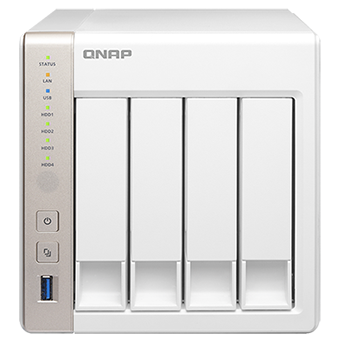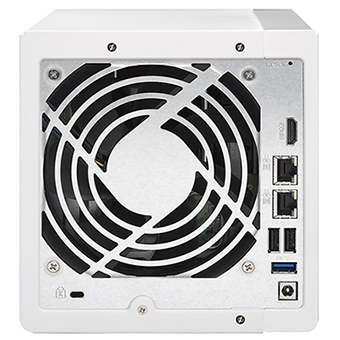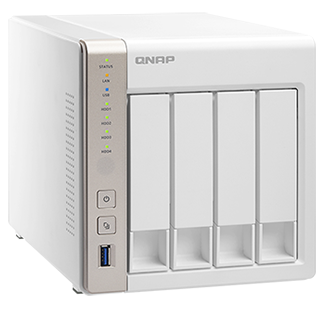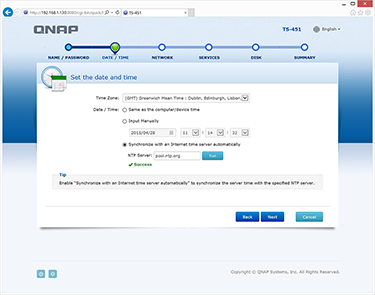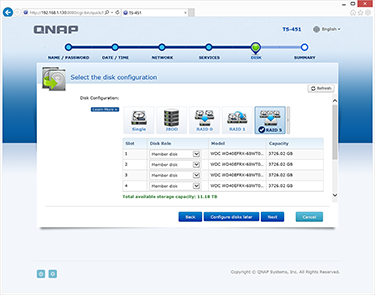Introduction
Qnap's four-bay TS-451 NAS was launched to much acclaim back in July 2014, and with good reason: the SOHO server was one of the first to feature an Intel 'Bay Trail' processor and could rightly claim to offer cutting-edge technology in a user-friendly package.
The processor in question, an Intel Celeron J1800, is a dual-core 64-bit SoC that can be considered a step up from the usual Intel Atom, bringing increased performance to mid-range NAS solutions. Making the most of Intel's varied portfolio, Qnap's choice of processor includes Quick Sync Video for real-time hardware transcoding, as well as support for virtual machines courtesy of Intel VT-x.
Such features made the TS-451 a formidable choice for home users or small businesses, but there was a problem: cutting-edge technology doesn't come cheap, and at launch prices started at a staggering £550 for the basic 1GB model, or £650 for a unit outfitted with 4GB of memory as standard.
Hefty figures, but fast forward a few months and prices haven't merely stabilised - they've tumbled, with the TS-451 and TS-451-4G now fetching a far more palatable £350 and £400, respectively. At those figures the NAS is well worth another look, so we have the 4GB model on the test bench today.
Finished in white with silver trim, the TS-451 is as easy on the eye as a NAS can be and is clearly designed with home users in mind. However, while more attractive than the usual black boxes, build quality is merely average - the chassis' plastic construction leaves something to be desired, and the pull-out drive trays are among the flimsiest we've seen. They do support 2.5in or 3.5in disks, but the pull-out mechanism feels very basic, they aren't tool-free, and the individual trays aren't numbered.
A shame, really, but do keep reading as aside from cheap-feeling plastic construction, the TS-451 is a very well-rounded package. LEDs on the front of the box keep you updated on current status (as do audible beeps) and the power button is joined by a one-touch copy button that works in conjunction with the front-facing USB 3.0 port.
Around back, a single 120mm fan is tasked with cooling the entire unit and is flanked by a column of connectivity options. These include, from bottom to top, a port for the bundled 90W external power supply, three further USB ports (one of the SuperSpeed variety), dual Gigabit Ethernet ports with support for trunking and failover, as well as a HDMI 1.4a output that can be used to connect the TS-451 directly to your HDTV.
Aside from acting as a centralised storage server, the Qnap NAS touts comprehensive backup options, simplified remote access via myQnapCloud, simultaneous real-time transcoding for up to five users, an integrated Kodi-based media player (formerly XBMC) and, with the aid of Virtualisation Station, can double as a fully-fledged computer running your operating system of choice.
Such an array of functionality could bamboozle end users, but Qnap's QTS operating system ensures that isn't the case. A well-thought-out setup wizard has the box up and running relatively quickly, though building the initial RAID array can take a while - our quartet of 4TB WD Red hard disks took the best part of nine hours to fully synchronise.
Gradually refined over the years, the QTS software is now at version 4.1 and in our estimation sits a close second to Synology's DiskStation as one of the most capable NAS operating systems available. Well presented and easy to get around, it does a good job of making the array of functions easily accessible and the built-in app store continues to introduce new possibilities at a steady rate.
We've merely scratched the surface of what the TS-451 could do - it's worth paying a visit to the official product page for a more comprehensive list of features - but the question we now want to answer is what kind of performance can we expect from the Intel SoC? Let's move on to the benchmarks.






